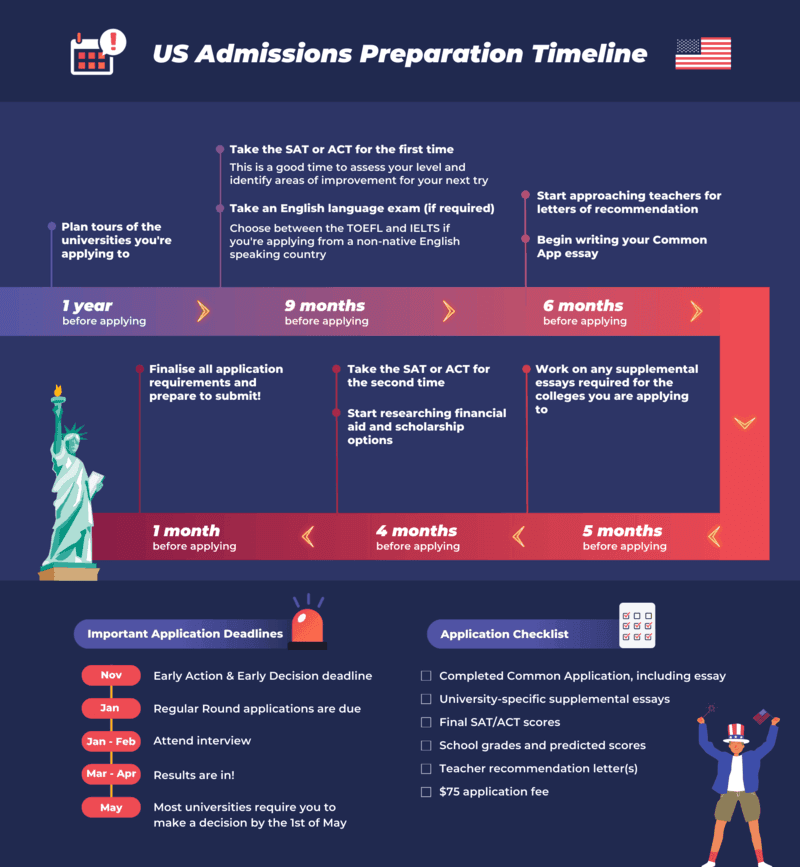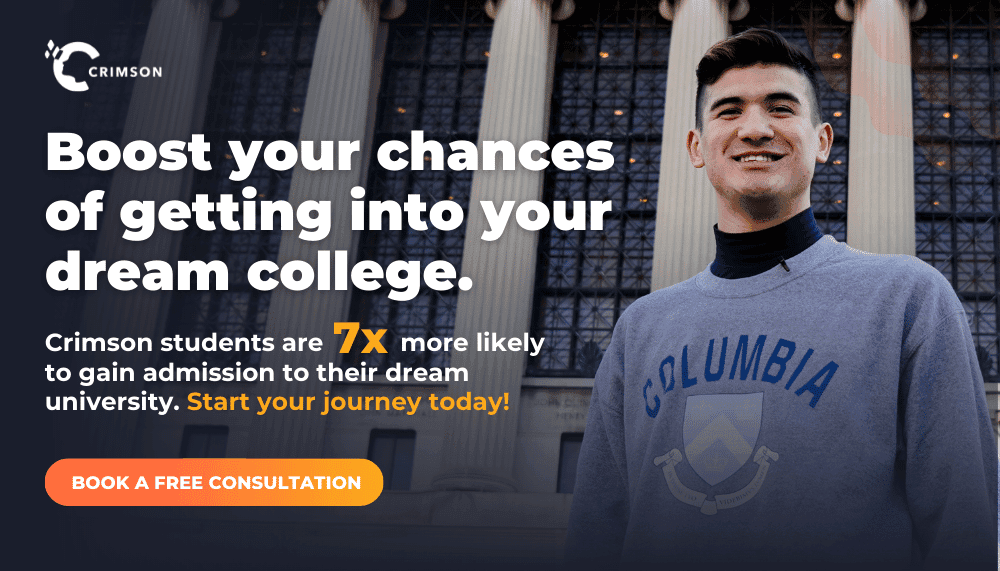How To Apply To US Universities From Australia

Summary
The US is one of the world’s most popular destinations for studying abroad, with more than one million international students studying there each year. Not only are eight of the top 10 global universities located in the US, but it’s also home to more than 5,000 higher education institutions across the country. This blog will break down everything you need to know about applying to US universities and why you should consider it.
The US is one of the world’s most popular destinations for studying abroad, with more than one million international students studying there each year. Not only are eight of the top 10 global universities located in the US, but it’s also home to more than 5,000 higher education institutions across the country. This blog will break down everything you need to know about applying to US universities and why you should consider it as an international student.
Why Apply to US Universities
Students from all over the world choose to study in the US for several reasons:
- Freedom and flexibility to explore classes in any subject they want and not having to declare a major until the end of the second year
- The prestige of a US degree
- Opportunities to engage in activities and clubs with a diverse campus community
- Generous internship and undergraduate research opportunities
- Specialised services that support international students
- Superior job prospects due to their proximity to top businesses
The Common Application recently reported that the number of international applicants increased at nearly triple the rate of domestic applicants, further validating the growing interest in a US education. The challenges of the pandemic didn’t deter international students from enrolling for the first time at a US institution. Higher education institutions reported a 68% increase in international enrolment for Autumn 2021 compared to a 46% decline reported in Autumn 2020.
Australian students Allie & Chris breakdown how to apply to American Colleges
What You Need To Know About Applying to US Universities
One of the biggest challenges that Australian students face when it comes to visualising their successful admission to their dream US universities is a lack of knowledge around what it takes to get in.
The good news is, if anything the US application process is a much more ‘human’ one with universities genuinely interested in who you are and what matters to you. That’s why it covers everything from your academics and extracurriculars to your personal passions and future ambitions. This holistic evaluation helps admissions officers learn more about you to determine if you are a right ‘fit’ for their university and that their campus will be somewhere where you will thrive.
The US university application process is quite comprehensive in comparison to the UAC process in Australia and so we’ve come up with a list of what you need to know if you want to apply to American universities specifically for Australian students.
- Plan Early. Choose 5-8 universities and determine which type of application they accept. Many universities use the Common Application or the Coalition Application, and some require you to apply directly to the school.
- US universities value extracurricular activities. Choose activities you are passionate about and aim for leadership positions within them.
- Good grades and SAT/ACT scores are still one of the most important parts of your application.
- US Universities do acknowledge and understand the ATAR. Admissions offices employ specialised experts who are familiar and understand high school curriculums from around the world. In the context of Australia, there would be experts who understand how the ATAR is interpreted, and how local curricula like the HSC, VCE, WACE are constructed. Therefore you can have confidence that you can apply to top US universities using your Australian grades.
- The US personal essay isn’t the same as the UK personal statement. The UK universities are looking for subject-focused content, while US universities want you to tell a compelling story and showcase your personality.
- Applying early has advantages. Applying early can increase your chance of acceptance to many top schools. However, you can only apply early to one university, and the decision is binding. Only apply early to a school you're 100% sure you want to attend.
- It’s ok to be unsure of your major. You can mark “undecided” on most US university applications.
- Don’t forget the application fee. It’s typically between $75-100 USD.
- Acceptance isn’t conditional. If you’re accepted, you’re in!
The US application process can be complicated, and some universities, like MIT and any of the University of California schools, do not use the Common Application. Others have unique requirements beyond the general application. Universities will go into detail about their requirements on their websites. Carefully read the entire application requirements before you get started.
If you’re still unsure you have everything you need, contact one of our academic advisors at Crimson Education. They will walk alongside you and help you navigate the journey. Let’s work together to achieve your academic dreams!
How Aussie student Julian got into Dartmouth
Key Requirements For US Universities
If you want to study in the USA as an Australian student, here is what top American colleges require:
Exceptional Academics
Most US universities take a holistic approach when reviewing applications, but that doesn’t mean grades aren’t important. Grades are arguably the most crucial part of your college application, and your chances of studying in the USA are much higher if you have stellar grades. You will need to provide a copy of your high school transcript to showcase this.
You can use our free HSC/VCE to GPA calculators to find out how your current grades translate to a US 4 point GPA scale!
Outstanding Test Scores
The second most important part of your college application is your test scores. While many colleges are going test-optional, some still require an SAT or ACT score, especially from international students, because it gives them a better understanding of your academic abilities. Most schools look for students with scores in a specific range, so check with your top schools to learn if your scores fit into that range.
Diverse Extracurriculars
Extracurriculars demonstrate who you are outside of the classroom and provide an opportunity to showcase your leadership skills and community involvement. Universities are not looking for applicants who have participated in dozens of extracurriculars. Instead, it’s better to dig deep into a subject, dedicate significant time to it, and ideally use it to propel you into a world-changing career.
Thoughtful Essays
Your essays build upon your applications, giving admissions teams a holistic picture of who you are and how you might contribute to their university. They should include thoughtful and unique information that’s not already in your application.
Strong Letters of Recommendation
Recommendation letters help build your holistic application by allowing people in your life to give their personal and professional opinions about your academic performance, character and drive. If you want to receive favourable and convincing recommendations, establish strong relationships with teachers, key staff, and leaders of your extracurricular activities.
Supplemental Documents
- Your grade and predicted grades
- Personal statement
- Reference letters
- Copy of passport
- Financial evidence you can cover the cost of university
- Proof of English language proficiency (if applicable)
To learn more, download our free eBook, which provides a complete breakdown on building the perfect application to gain admission into top US universities!
Applying for Scholarships & Financial Aid at US Universities
Studying at university is generally expensive. Being an Australian citizen allows you to benefit from the HECS scheme if you apply to Australian universities. The Australian Government gives you a loan that you can pay off with voluntary payments or pay off gradually with your wages via tax in Australia.
This system is familiar to Australian students, which is why the US system can feel confusing when words like ‘financial aid’ and ‘scholarships’ come into play.
The good news is, that while studying at a US university is more expensive than studying at a domestic institution, there is more financial aid available in the US system. In fact 75% of the students at Harvard are on some form of financial aid!
Included in US college university fees are all food and accommodation (if students are living on campus which the great majority do) so the fees can be seen as lifestyle support beyond the academic tuition.
When applying for aid families are ‘means tested’ and if admitted the university makes up any gap the family cannot afford. The even better news is, financial aid is not a ‘loan’ so does not need to be ‘paid back’. That said international students can also take out loans to supplement the funding of their studies
Further, ‘need-blind’ colleges don't take your financial situation into account when considering your application (while need-aware schools do consider your application as part of many deciding factors).
Some examples of need blind universities include:
- Harvard
- Princeton
- Yale
- Amherst
- MIT
Finally there are colleges that offer full-need financial aid to sufficiently cover the family’s needs. However, some scholarships have specific requirements, so it’s important to check with the university to find out the details.
The types of scholarships international students can apply for include:
- Crimson Scholarships
- University scholarships
- Financial scholarships
- Merit scholarships
- Country-based scholarships
- Government-funded scholarships
- Privately-funded scholarships
You can also book a free consultation with one of our academic advisors to learn more about scholarships and financial aid that may be applicable for you!
Key Deadlines for US University Applications
Many international students find the US application process complicated. By breaking down the steps into manageable pieces, you will find the process much less daunting and straightforward. Check out the chart below for a complete US admission preparation timeline.

Here are the steps you need to take to apply to American Universities as an International Student
1. Research colleges
Start researching where you might like to study one year before you start applying to universities. Check out each school’s acceptance rates, location, tuition, campus activities, etc.
2. Make a list of your top universities
Make a list of target, reach, and safety schools. Pick schools in all the categories, so you will have more options when acceptance letters come out. Our college admissions calculator can help you find the right universities!
3. Take college tours
Plan a tour (or virtual tour) of the schools on your list.
4. Start taking tests.
Take the SAT/ACT for the first time about nine months before applying to university.
5. Ask for letters of recommendation.
Start approaching teachers for recommendations about six months before you apply for university.
6. Write your essays
Start writing and refining your college essays, including the Common App essays and/or supplemental essays.
7. Test again
If you’re not happy with your SAT/ACT scores, consider retaking the tests about four months before applying for university.
8. Research financial aid and scholarships
About four months before you apply, research all your financial aid opportunities and any scholarships that will help you pay for university.
9. Put your application together
You should have all the application pieces ready about one month before it’s due. Check and double check you have all the details before submitting your application.
10. Apply for University!
Check your application one last time and press submit!
How do I find an American University that’s Right for me?
You’re the only person who can answer this question. Universities are as unique as the students who go there. If you know what you want to study, choose a university specialising in that study area. If you’re still unsure of what you want to learn, check out:
- Top 10 Degrees in Demand for the Future
- 10 Best Liberal Arts Colleges in the US
- The Best Ivy League Schools
- The Best UC Schools
Think about your academic and personal preferences and goals. Are you interested in a liberal arts education, an Ivy League school, or maybe a school in the University of California system?
Talk with friends, family, and alumni about different schools. Consider visiting your favourite campuses or going on a virtual tour if you can. Crimson has a YouTube channel with videos about students getting into college, a day in the life of a student, and much more! Crimson counsellors can also help you find the universities that best fit your interests and goals.
If you’re wondering if you have the right grades and test scores to get into your top universities, check out our college admissions calculator.
How Crimson Pathfinder can help you with Applying to American Universities
Introduction to Crimson Pathfinder
Applying to American universities takes time, planning, effort, and patience. It’s easy to overlook a step or miss a deadline.
Crimson recently released Pathfinder - a comprehensive in-app tool that not only helps you stay on track but helps you quantify the value of activities you do in preparation to apply to US universities.
Contained within the Crimson app, Pathfinder is a master list of everything you can do during school to increase your chances of admission to top US universities. Pathfinder includes over 280 goals, each with an assigned point value based on how much admissions officers will value that achievement.
Pathfinder ensures you stay on track between now and when you apply to university. It accurately predicts your admission results (based on your achievements) with unbelievable accuracy. Combined with guidance from your personalised strategist, you’ll become a master of your US university applications!
Crimson Education’s academic advisors walk with you through each step of the process. They keep you on track, help you get ready for testing, provide essay reviews, and more! Best of all, Crimson students are 4x more likely to gain admission into their dream university! If you’re interested in applying to a US university or getting started with Pathfinder, contact a Crimson advisor today!
What Makes Crimson Different
Key Resources & Further Reading
- Join our free webinars on US university applications
- Free eBooks and guides to help with the college application process
- How to get into Ivy League Schools
- Make the College Application process simpler with Pathfinder
- What Do Colleges Look For In Students & How To Stand Out
- How to prepare for College in high school









